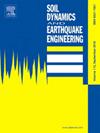An open-source ABAQUS UEL implementation of SBPML for wave problems
IF 4.2
2区 工程技术
Q1 ENGINEERING, GEOLOGICAL
引用次数: 0
Abstract
In the numerical simulation of wave problems, it is often necessary to truncate the unbounded computational domain at a finite distance to reduce the requirement of computational resources. To manage this truncation, artificial boundaries are introduced, among which the Scaled Boundary Perfectly Matched Layer (SBPML) is regarded as a reliable strategy. In this paper, we implement the SBPML element into the commercial software ABAQUS using the User-Defined Elements (UEL) subroutine. The key equations of the SBPML, the procedures of meshing for the SBPML domain, and the implementation workflow of the subroutine are given in details. Four benchmark examples of wave propagation problems in unbounded domains are presented to demonstrate the accuracy and effectiveness of the proposed method. Furthermore, the application of the UEL in nonlinear seismic soil-structure interaction analysis is demonstrated by evaluating the seismic response of a five-layer alluvial basin in a homogeneous half space and an aboveground-underground integrated structure-multilayer soil system under obliquely incident earthquake waves. Using the proposed UEL, all wave propagation analyses can be directly implemented in ABAQUS with a seamless workflow. To facilitate the use of the proposed approach, the codes of the UEL are published in an open-source format.
求助全文
约1分钟内获得全文
求助全文
来源期刊

Soil Dynamics and Earthquake Engineering
工程技术-地球科学综合
CiteScore
7.50
自引率
15.00%
发文量
446
审稿时长
8 months
期刊介绍:
The journal aims to encourage and enhance the role of mechanics and other disciplines as they relate to earthquake engineering by providing opportunities for the publication of the work of applied mathematicians, engineers and other applied scientists involved in solving problems closely related to the field of earthquake engineering and geotechnical earthquake engineering.
Emphasis is placed on new concepts and techniques, but case histories will also be published if they enhance the presentation and understanding of new technical concepts.
 求助内容:
求助内容: 应助结果提醒方式:
应助结果提醒方式:


